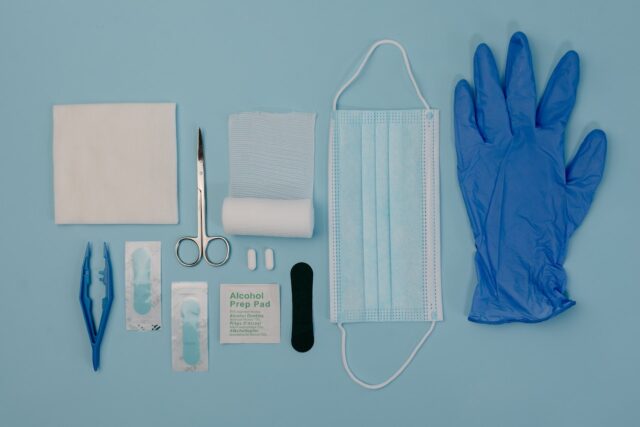Every family should have a well-stocked first aid kit to keep at home and in their vehicles. While you can buy a first aid kit that is already stocked, it is also easy and affordable to put together your own. Here are eight essentials that need to be in every first aid kit.
Bandage Supplies for Cuts and Wounds
A key component of any first aid kit is a supply of bandages to cover cuts and wounds. You are going to want to stock bandages in a few different sizes and shapes. For example, in addition to rectangular bandage strips, be sure to also include butterfly bandages to close deeper wounds. Other essentials for covering wounds include elastic wrap bandages, roller gauze, and adhesive tape.
Hydrogen Peroxide
A 35% hydrogen peroxide solution is an invaluable addition to any first aid kit. This natural product serves as a mild antiseptic to prevent infection in minor scrapes and burns. You can also use the solution as a mouth rinse to relieve irritation or canker sores. While you should not use the solution for deep wounds, it is suitable for cleaning out smaller cuts and scrapes.
First Aid Tools
There are a variety of tools that should remain in your specialty first aid kit. Items to include are tweezers for removing splinters, small surgical scissors, assorted safety pins, an aluminum finger splint, a bulb suction device to flush out wounds, and a syringe to administer medication. Cotton balls and cotton swab applicators are great tools to apply topical medications and ointments.
Gels and Lotions
A small tube of essential gels and lotions is another good item to include in your kit. Aloe vera gel will bring relief in the event of a sunburn. Because sunburned skin immediately begins to lose moisture, the soothing aloe will replenish these stores and promote faster healing.
Calamine lotion is always great to have on hand when camping or spending time outdoors where mosquitoes are present. Both of these products will make you more comfortable if you end up with a rash of bites or a sunburn. Lastly, include a tube of hydrocortisone cream to treat a myriad of rashes, allergic reactions, and more.
Cold Packs
You can never have too many cold packs in your first aid kit. Use a cold pack to ease pain from injuries and reduce swelling triggered by minor injuries. Some cold packs are made of gel that turns into ice when activated, requiring no special refrigeration or freezing. These packs are extremely portable and compact, making them good additions to this kit.
Medications
No first aid kit is complete without a variety of over-the-counter medications. Start with stocking your kit with cough and cold medications. An antihistamine to treat allergies or reactions is also important.
Round out your kit with laxatives, antacids, and anti-diarrhea medication. Be sure to keep an extra and current epinephrine pen in your first aid kit if a family member suffers from anaphylactic allergies.
Emergency Information
Your first aid kit is also a good place to tuck away numbers, including contact information for all of your healthcare providers. Numbers for local emergency services, emergency road service, and poison control may also prove to be a lifesaver. Get extra prepared by including copies of medical consent forms for all family members.
Miscellaneous Items
You never know when you may be out and about and need extra sunscreen and insect repellent. Keeping small amounts of these outdoor essentials in your vehicle’s first aid kit will tide you over until you reach a store to purchase what you need.
Other essentials to keep in your kit are surgical masks, petroleum jelly, a thermometer, duct tape, hand sanitizer, and an eyewash solution. Lastly, do not forget to include a first aid manual in case you need advice and cannot access the internet.
Bottom Line
It is good practice to check the kit regularly to make sure that nothing needs to be replaced. This includes checking for expiration dates on all medications. You should get in the habit of doing an inventory of all of your kit items at least every six months.







